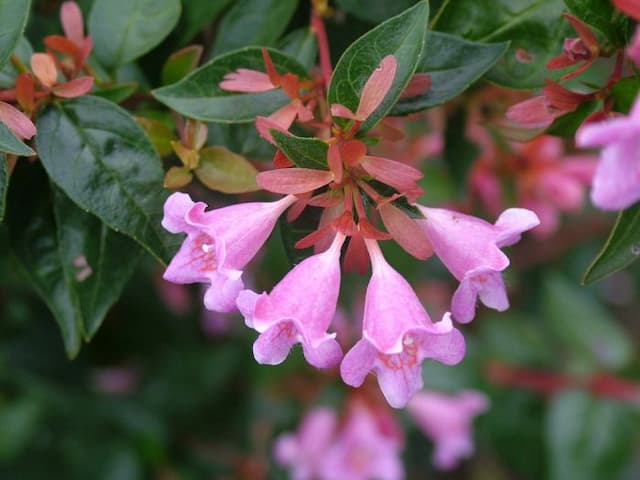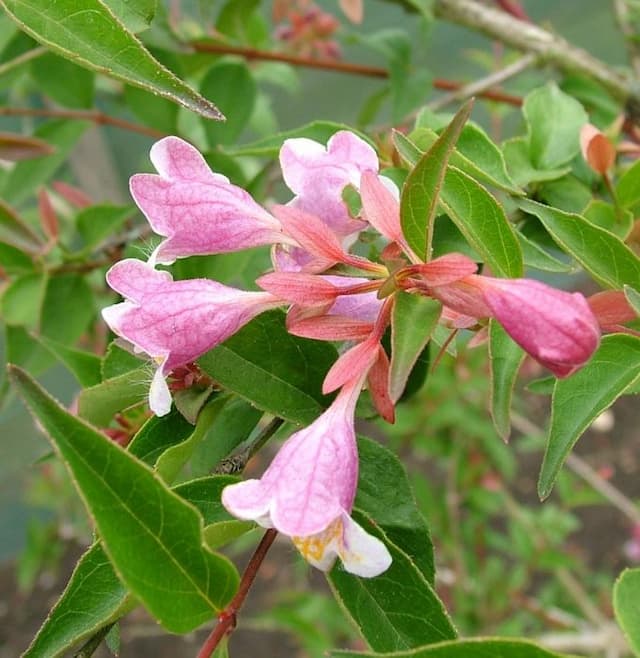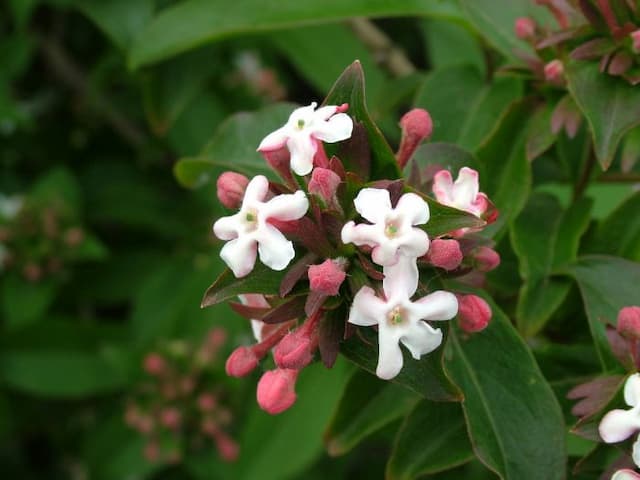Goldflame honeysuckle Lonicera × heckrottii

ABOUT
The plant commonly known as Goldflame Honeysuckle is a visually striking vine characterized by its vibrant and colorful flowers. Its blossoms exhibit a mesmerizing fusion of pink and orange hues on the outside while the insides are a creamy yellow. These tubular flowers are uniquely shaped, which makes them highly attractive to hummingbirds and other pollinators. The foliage of Goldflame Honeysuckle is equally attractive, with leaves that display a bluish-green color. The leaves grow opposite each other along the stems, providing a lush backdrop for the flowers. During the growing season, the plant continues to produce these delightful blooms, which can exude a sweet and pleasant fragrance. Additionally, as the season progresses, the Goldflame Honeysuckle may produce inedible berries that change from green to a deep reddish color, signaling their maturity. These berries are typically more attractive to birds than to humans. Toward the conclusion of the growing season, the leaves of this vine may take on new coloration, featuring hints of red and yellow that signal the coming of cooler temperatures. Overall, the plant's appearance is notable for its colorful and fragrant flowers, dense foliage, and changing seasonal colors that provide year-round interest in the garden setting.
About this plant
 Names
NamesFamily
Caprifoliaceae
Synonyms
Goldflame Honeysuckle, Heckrott's Honeysuckle, American Woodbine
Common names
Lonicera × heckrottii
 Toxicity
ToxicityTo humans
The common name for Lonicera × heckrottii is Goldflame Honeysuckle. Generally, honeysuckles are not considered highly toxic to humans. However, some species have berries that contain saponins, which can be mildly poisonous if ingested in large quantities. Symptoms of poisoning can include stomach upset, diarrhea, nausea, and vomiting. It is advisable to avoid ingesting parts of this plant, particularly the berries, and to keep them away from children who might be tempted to eat them.
To pets
Goldflame Honeysuckle is not typically listed as a toxic plant to pets. However, as with humans, the berries might contain low levels of saponins which could cause mild gastrointestinal upset if consumed in significant amounts by pets. Possible symptoms of poisoning in pets include vomiting, diarrhea, and abdominal pain. It is wise to prevent pets from ingesting large quantities of any part of the plant to avoid potential digestive issues.
 Characteristics
CharacteristicsLife cycle
Perennials
Foliage type
Deciduous
Color of leaves
Green
Flower color
Mixed
Height
10 feet (3 meters)
Spread
6 feet (1.8 meters)
Plant type
Climber
Hardiness zones
5
Native area
Cultivar
Benefits
 General Benefits
General Benefits- Attracts Pollinators: Lonicera × heckrottii is known for attracting bees, butterflies, and other beneficial insects, which helps in pollination of gardens and ecosystems.
- Ornamental Value: This plant, commonly known as Goldflame honeysuckle, has attractive and fragrant pink to red flowers that can enhance the visual appeal of any landscape.
- Drought Tolerance: Once established, Goldflame honeysuckle can tolerate periods of drought, making it suitable for xeriscaping or low-water gardens.
- Easy to Grow: It is generally easy to care for and can thrive in a range of soil types, though it prefers well-drained soils.
- Provides Habitat: The dense foliage and twining habit of Goldflame honeysuckle provide shelter and nesting sites for birds.
- Fast Growth: This plant can grow quickly, providing rapid coverage for trellises, fences, and other structures in the garden.
- Shade Tolerance: Goldflame honeysuckle can perform well in partial shade, offering versatility in garden design and plant placement.
- Privacy Screen: Because of its dense growth, it can be used to create living privacy screens or to hide unsightly areas.
- Seasonal Interest: Its changing colors throughout the season, from flowers in spring and summer to more subtle foliage hues in fall, provide year-round interest.
- Erosion Control: The extensive root system of Goldflame honeysuckle can help to stabilize soil and prevent erosion on slopes or banks.
 Medical Properties
Medical PropertiesThis plant is not used for medical purposes.
 Air-purifying Qualities
Air-purifying QualitiesThis plant is not specifically known for air purifying qualities.
 Other Uses
Other Uses- Honeysuckle hedges can provide a dense and attractive boundary that may deter unwanted foot traffic through a property.
- The fast-growing nature of Honeysuckle can be used for quick coverage of unsightly fences or structures in a garden.
- With its twining vines, Honeysuckle can be trained to grow over arbors or pergolas, creating a beautiful, fragrant outdoor living space.
- The plant's durable wood can be used for making small carved items or inlay work in woodworking projects.
- The nectar-rich flowers can be used for cut-flower arrangements, adding a delicate fragrance to bouquets.
- Honeysuckle can be used in natural dyeing processes, where the flowers or leaves produce colors for textile dyeing.
- Its robust growth can be utilized for erosion control on slopes or in areas prone to soil degradation.
- Birds often use the dense foliage for nesting, so planting Honeysuckle can help provide shelter for local avian populations.
- The sweet scent of Honeysuckle flowers can be captured in homemade potpourri or scented sachets for drawers and closets.
- During festive occasions, the vines can be used to create natural, decorative garlands that add a rustic charm to the decor.
Interesting Facts
 Feng Shui
Feng ShuiThe Gold Flame Honeysuckle is not used in Feng Shui practice.
 Zodiac Sign Compitability
Zodiac Sign CompitabilityThe Gold Flame Honeysuckle is not used in astrology practice.
 Plant Symbolism
Plant Symbolism- Love and Devotion: Lonicera × heckrottii, commonly known as Goldflame Honeysuckle, often symbolizes strong affection and enduring love, reflecting the plant's vigorous and entwining growth habit which can represent two lives intertwined.
- Generosity: With its abundant and fragrant flowers, Goldflame Honeysuckle is also a symbol of generosity, suggesting a willingness to give without expecting anything in return.
- Bonding: The twining nature of honeysuckles can represent the bond between people, making it a symbol of friendship and brotherly love.
- Protection: In some traditions, honeysuckles are thought to ward off evil, providing protection to those nearby; perhaps due to their dense growth which can create a natural barrier.
 Water
WaterThe Gold Flame Honeysuckle, or Lonicera × heckrottii, should be watered deeply once a week during its active growing season, allowing the soil to become moist but not saturated. During periods of drought or extreme heat, increase watering to twice a week. Each watering session should be around 1 to 1.5 gallons for each plant, ensuring that water reaches the root zone. In the winter or dormant season, reduce watering frequency to every two to three weeks depending on soil dryness and weather conditions, as overwatering can lead to root rot.
 Light
LightGold Flame Honeysuckle thrives in full sun to partial shade, so the ideal spot would be where the plant can receive at least 6 hours of direct sunlight per day, while also having some relief from the intense afternoon sun. It can manage in less lit areas but flowering will be more prolific with ample sunlight.
 Temperature
TemperatureThe Gold Flame Honeysuckle prefers temperate climates and fares best in a temperature range between 60 to 85 degrees Fahrenheit, though it can survive brief periods of colder drafts or temperatures down to about 20 degrees Fahrenheit. Avoid planting in areas where temperatures regularly drop below this range to prevent frost damage.
 Pruning
PruningPruning Gold Flame Honeysuckle is essential for maintaining a tidy growth habit, controlling size, and encouraging more blooms. Prune the plant in late winter or early spring before new growth starts, removing any dead or damaged stems and opening up the center for better air circulation. Prune back about one third of the older branches each year to rejuvenate the plant and stimulate new, more vigorous growth.
 Cleaning
CleaningAs needed
 Soil
SoilGoldflame Honeysuckle thrives best in well-draining soil enriched with organic matter like compost. A balanced mixture of loam, peat moss, and perlite or sand works well to provide the necessary drainage and fertility. This plant prefers a soil pH ranging from 5.5 to 8.0, slightly acidic to slightly alkaline.
 Repotting
RepottingGoldflame Honeysuckle, being a vigorous grower, should be repotted every few years to prevent it from becoming root-bound and to refresh the soil. Repotting is best done in late winter or early spring before the growing season starts.
 Humidity & Misting
Humidity & MistingGoldflame Honeysuckle is flexible regarding humidity and can adapt to a wide range, but it does best in conditions that replicate its natural habitat, which typically involves moderate to high humidity levels.
 Suitable locations
Suitable locationsIndoor
Ensure bright indirect light, regular watering, and support for climbing.
Outdoor
Plant in sun to partial shade and provide a trellis or support.
Hardiness zone
5-9 USDA
 Life cycle
Life cycleGoldflame honeysuckle (Lonicera × heckrottii) begins its life as a seed that, once sown, germinates into a small seedling. This stage is followed by a period of rapid vegetative growth where the plant develops stems, leaves, and a root system. As it matures, it enters the flowering phase during which fragrant, tubular flowers bloom in shades of pink and yellow, primarily in the summer. After pollination, often by hummingbirds or insects, the flowers produce small, inedible red or black berries as fruits, which contain seeds for the next generation. Throughout its life cycle, the honeysuckle may experience multiple blooming cycles depending on the climate and conditions. During autumn, the plant enters dormancy, a phase of reduced activity where growth slows down or stops until favorable conditions return in spring.
 Propogation
PropogationPropogation time
Spring-Early Summer
The most popular method of propagation for the Goldflame Honeysuckle (Lonicera × heckrottii) is through semi-hardwood cuttings, usually undertaken in late summer. To do this, a gardener will select a healthy stem that has begun to mature but is not yet fully woody and cut a section about 4 to 6 inches (approximately 10 to 15 cm) long. It's important for the cutting to have several leaf nodes as these are potential growth points. The bottom leaves are then removed, and the cut end dipped into rooting hormone to enhance root development. The treated cutting is then inserted into a potting mix, ensuring at least one or two nodes are buried under the soil. The cutting should be kept in a warm, humid environment with indirect light. Roots typically develop within a few weeks, after which the new plant can eventually be transitioned to garden soil.








![Himalayan honeysuckle [Golden Lanterns]](/_next/image?url=https%3A%2F%2Fplants-admin.emdemapps.com%2Fimages%2Fplants%2F%2Fimages%2F604b55302cc87.png&w=640&q=75)
